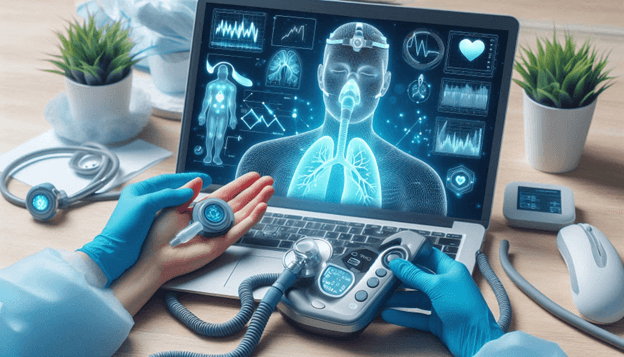Sleep Apnea Devices: How Are They Helping Healthcare Providers Improve Patient Sleep?
Published Date: 12 Oct 2024
Sleep Apnea is a greatly severe sleep disorder characterized by a temporary pause of breathing during your sleep. The disease impacts several million people in the world and is connected with such undesirable consequences as heart disorders, excessive daytime sleepiness, and cognitive impairments. Technologies used in sleep apnea have been used for sleeping and delivering the right treatment to patients.

Functions of Sleep Apnea Equipment
The appliances used in sleep apnea are important in diagnosing the problem because they offer solutions that improve sleep and general health. The main categories of equipment for treating sleep apnea are as follows:
- Continuous Positive Airway Pressure (CPAP) machines
To cure apnea obstructive sleeping Devices that provide CPAP are supplied to the patient throughout the night to keep the air passages open. As such there is a motor, hose, and mask that can be fitted to the mouth or nose of the user. Apart from reducing the probability of other diseases linked with it such as heart disease, CPAP can also improve the quality of sleep and help to suppress snoring. They found that the regular use of CPAP improves their general quality of life substantially if they have sleep apnea.
- Auto-CPAP (APAP) Machines:
APAP devices adjust the pressure according to the user’s breathing needs and cycle during the period of the night. Due to this technology, therapy is personalized and thus more comfortable than the standard CPAP machines. If apneas or hypopneas appear in conditions of using APAP devices, the devices can recognize these events and adjust the pressure to offer the best possible airflow. Those patients who lie in different positions at night or have different pressure needs seem to benefit most from them. If used by individuals who have sleep apnea, then constant use can help enhance one’s general health as well as the quality of their sleep.
- (Bi-PAP) Machines:
Two distinct pressure settings are available on BiPAP machines: One key for a faster rate and the other for a slower rate of breathing; one setting for intake of oxygen and a slower rate of breathing out. This design makes it a good replacement for people who have stopped using CPAPs as it helps those with a problem breathing against constant pressure. It can be most beneficial in treating COPD, complicated sleep apnea as well as other respiratory illnesses; the biphasic pressure ventilation. These gadgets provide the kind of therapeutic touch that is needed for sleeping and regenerative work and perhaps the angle can be tweaked to optimize comfort.
- Wearable Sleep Technology:
Smartwatches, fitness trackers, dedicated heart rate tracking sensors, oxygen level sensors, and sleep Trackers are some examples of wearable sleep technology for sleep apnea. These gadgets often detect potential apnea incidents with detailed algorithms asserting to users concerning breathing difficulties and quality of sleep. Some wearables offer individual advice and suggestions, as they are capable of connecting to mobile applications. You can obtain life changes for better sleep health and guide the users with their state but, they do not substitute for a formal diagnosis and treatment.
The advantages of Sleep Apnea devices for medical professionals
- Better Diagnosis and Monitoring: HSATs aim to make the screening process more accessible, quicker, and cheaper so that healthcare providers can begin investigations of sleep apnea more effectively and precisely.
- Improved Patient Compliance: Current and more comfortable technologies include, new technologies that are easier to use and have better patient adherence rates that are very vital for treatment.
- Data Collection and Analysis: Modern Sleep Lab equipment makes it possible for medical experts to have the details of the usage of the equipment by patients, including their sleep patterns to ensure the appropriate program to be offered meets the patients’ needs.
- Patient Education and Support: Many modern devices have applications or Web sites that help patients become more knowledgeable about their conditions and engage in their treatment.
Obstacles and Things to Think About
• Device Tolerance: If a patient is incapable of making the necessary changes and starts using a CPAP or other devices, the patient is likely to become nonadherent.
• Expense and Accessibility: While many devices are insured, copayment or out-of-pocket needs might present a challenge to patients and is especially daunting, especially in third-world countries.
• Individual Variation: Treatment protocols are however required to define the best solution due to the differences in patient response to the device.
Conclusion
Sleep Apnea gadgets are changing the way doctors deal with a condition that affects millions of people around the world. These gadgets are enhancing patient engagement and giving effective care options that eventually enhance sleep standards and general health. Further technological developments may also be expected in the future thereby enhancing the outcome of managing sleep apnea thus patient care and quality of life.
Maximize your value and knowledge with our 5 Reports-in-1 Bundle - over 40% off!
Our analysts are ready to help you immediately.
